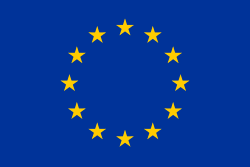Europahymnen
| Nationalsång i | |||
|---|---|---|---|
| Musik | Ludwig van Beethoven | ||
| Antagen | 19 januari 1972 (Europarådet) 29 juni 1985 (EG) | ||
| Musikexempel | |||
Europahymnen består av en del av den sista satsen av Ludwig van Beethovens nionde symfoni, som är en musiksättning till Friedrich von Schillers dikt Till glädjen.
Melodin används bland annat också som tonsättning till dikten Visan om solen, månen och planeterna av Betty Ehrenborg och i en visa om månaderna som börja Januari börjar året.
Europahymnen antogs 1972 av Europarådet som hymn för Europa.[1] 1985 antogs den även som hymn för Europeiska gemenskaperna, sedermera Europeiska unionen.[2]
På grund av det stora antalet språk som används i Europeiska unionen är hymnen rent instrumental, och den tyska texten av Friedrich Schiller har ingen officiell status. Det finns även en relativt populär text på latin som börjar med "Est Europa nunc unita".
Hymnen valdes som utgångsmarch vid prins Carl Philips vigsel med Sofia Hellqvist den 13 juni 2015.
Se även
Referenser
Externa länkar
- Europahymnen Där går det att klicka vidare för att kunna lyssna på olika versioner av europahymnen.
| ||||||||||||||||||||||||||||
Media som används på denna webbplats
Författare/Upphovsman: Gnome?, Licens: GPL
SVG recreation of Gnome speakernotes.
The Flag of Europe is the flag and emblem of the European Union (EU) and Council of Europe (CoE). It consists of a circle of 12 golden (yellow) stars on a blue background. It was created in 1955 by the CoE and adopted by the EU, then the European Communities, in the 1980s.
The CoE and EU are distinct in membership and nature. The CoE is a 47-member international organisation dealing with human rights and rule of law, while the EU is a quasi-federal union of 27 states focused on economic integration and political cooperation. Today, the flag is mostly associated with the latter.
It was the intention of the CoE that the flag should come to represent Europe as a whole, and since its adoption the membership of the CoE covers nearly the entire continent. This is why the EU adopted the same flag. The flag has been used to represent Europe in sporting events and as a pro-democracy banner outside the Union.The Anthem of Europe, based on the final movement ("Ode to Joy") of Beethoven's 9th Symphony composed in 1823. Performed by the United States Navy Band. This is the short version without introduction.


